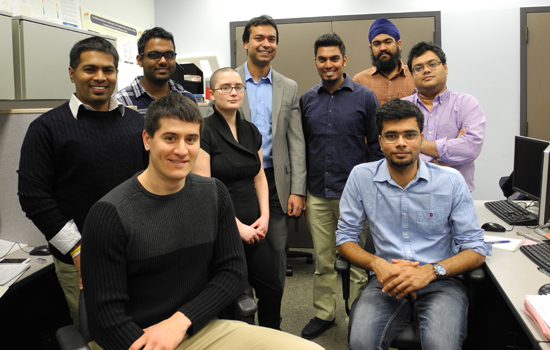Amlan Ganguly receives NSF CAREER Award
Research into use of new wireless interconnection networks could improve data communication at the both processor level as well as server-to-server efficiencies
Michelle Cometa
Part of the NSF career award focus is not only on supporting current, high result work being done by young professors, it is focused on how faculty include undergraduate, graduate and doctoral students in the research and how the information is integrated into classwork. Ganguly is shown with members of his student-research team.
Amlan Ganguly, a faculty member at Rochester Institute of Technology, recently received a National Science Foundation CAREER Award expected to total $596,512 over five years for “Energy-efficient data center with wireless interconnection networks.” The five-year grant award is being used toward further exploring the design of energy efficient data centers utilizing a communication infrastructure with wireless interconnections.
This new process projects 10 times the energy savings of current usage, Ganguly said. Datacenters are warehouse-scale computers comprising of thousands of individual servers used by organizations to store, manage and process data. The National Resource Defense Council states in its 2013 survey that combined U.S. data centers consume nearly 91 billion kilowatt hours of energy. This is estimated to increase to more than 140 billion kilowatt hours annually by 2020. Ganguly’s work using wireless frequencies, known as millimeter wave bands, could potentially help the computing infrastructure become greener by reducing the energy footprint of a data center by orders of magnitude.
“We want to revolutionize that mechanism of communication within servers with wireless interconnects. It is important to reduce that energy footprint of computing in the data center because it is so high,” said Ganguly, an assistant professor of computer engineering in RIT’s Kate Gleason College of Engineering. “The crux of the approach is to replace the legacy internet-type of connections with the novel wireless technology which we project to be significantly more power efficient than the current state-of-the-art.”
Ganguly has a background in developing wireless interconnects within a single chip, or integrated circuit. His approach with this research is to scale the technology for direct chip-to-chip communication within a server and then between server-to-server within a data center. Wireless interconnects are a radio-frequency alternative to metal, usually copper, interconnects within electronic devices.
“It is a high gain, but it is also a high risk project in the sense that the challenges are huge, because we are talking about interconnecting potentially tens to hundreds of servers with the same frequency which means that there is a lot of cross talk, a lot of interference. We have to have an intelligent way of managing that communication,” he explained. His focus will be on using his individual chip framework within a much larger environment with the intent to achieve the same performance but at a much lower power point.
Ganguly will take a step-by-step approach starting with scaling up on-chip wireless communication to an intra-server level—similar to that found inside a large, high performance computer with multiple processors. He will continue with modeling interconnects across server environments.
“In another sense, sustainability can mean that computers last longer, are more reliable, more robust,” he said. “That is tied to this research in a slightly different way because what happens when a lot of power and energy is being consumed, computers heat up, and the heat affects the performance, and ultimately the lifetime of computers. By reducing power consumption, you prolong the life of a computer.”















